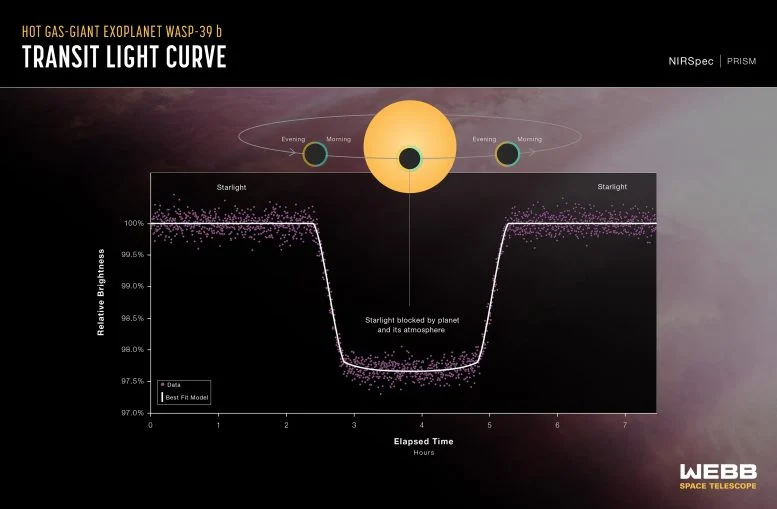
Although terminator near-infrared spectral analysis confirms differences in morning and evening atmosphere.
Since the date of discovery of the very first exoplanet in 1992, many thousands of planets orbiting stars beyond our solar system have been confirmed by a host of methods, from direct imaging and gravitational microlensing to measuring transits and astrometry. Over time, methods have evolved to study exoplanets, and today astronomers learn details on the atmospheric composition of these far-off worlds.
NASA’s James Webb Space Telescope continues to provide a further helping hand in this area of research, much expanding our present understanding about exoplanet diversity and atmospheres.
The latest? Webb helped astronomers tease out differences in the atmosphere between morning and evening on a tidally locked exoplanet.
Eternal sunrises, sunsets studied on distant world by Webb Space Telescope Researchers using NASA’s James Webb Space Telescope finally confirm what models have previously predicted: An exoplanet has differences between its eternal morning and eternal evening atmosphere. WASP-39 b is a giant planet, about 1.3 times the diameter of Jupiter, though holding about the mass of Saturn, orbiting a star some 700 light-years from Earth. More importantly, it’s tidally locked to its parent star. That means it has a perpetual day side and a constant night side—one side always exposed to its star, the other always shrouded in darkness.
Using Webb’s NIRSpec, they were able to confirm that WASP-39 b does indeed have a temperature difference between its eternal morning and eternal evening, with the evening appearing about 300 Fahrenheit degrees hotter than the morning. It also provided evidence for different cloud cover, with the forever morning portion of the planet likely being cloudier than its evening.

Advancing Studies of Exoplanet Atmospheres
Astronomers looked at WASP-39 b’s 2- to 5-micron transmission spectrum, a technique that observes the exoplanet’s terminator—the limb separating a planet’s dayside from its nightside. It means that one makes a transmission spectrum by comparing starlight filtered through the planet’s atmosphere as it moves in front of the star and the same unfiltered starlight detected when the planet is beside the star. Making just this very comparison, researchers can get information about temperature, composition, and other properties related to the atmosphere.
“WASP-39 b has become a real benchmark planet for the study of exoplanet atmospheres with Webb,” says Néstor Espinoza, an exoplanet researcher at the Space Telescope Science Institute and lead author on the study. It has an inflated, puffy atmosphere, so that signal arising from starlight filtered through the planet’s atmosphere is quite strong.”
Transit Light Curve for Hot Gas Giant Exoplanet WASP-39 b with Webb NIRSpec
The graph is a light curve of the WASP-39 star system, produced using NASA’s James Webb Space Telescope’s NIRSpec, showing the change in brightness with time as the planet transits the star. This observation was made using NIRSpec’s bright object time-series mode, which involves using a grating to spread light out from a single, bright object, such as the host star of WASP-39 b, and measure the brightness of every wavelength of light at set time intervals.
Video Credits: NASA, ESA, CSA, Ralf Crawford (STScI)
Temperature and Atmospheric Composition Insights
Previous Webb spectra of the atmosphere of WASP-39b that showed carbon dioxide, sulfur dioxide, water vapor, and sodium were averages over the entire day/night boundary – there was no rigorous effort to distinguish one side from the other.
Now, the new analysis builds two different spectra from the terminator region, in essence splitting the day/night boundary into two semicircles, one from the evening and one from the morning. This data showed the evening to be considerably hot: a scorching 1,450 degrees Fahrenheit, while the morning was relatively cool at 1,150 degrees Fahrenheit.
Hot Gas Giant Exoplanet WASP-39 b Transmission Spectrum (Webb NIRSpec)
This transmission spectrum, obtained with Webb’s NIRSpec PRISM bright object time series mode, reveals the near-infrared starlight blocked by WASP-39 b, an atmosphere of a hot gas giant exoplanet. The spectrum contains clear evidence for water and carbon dioxide and a temperature variation between the morning and evening on the exoplanet.
A new analysis of the transmission spectrum of WASP-39 b makes two different spectra from this stationary day/night boundary on the exoplanet—essentially splitting this terminator region into two semicircles, one from the evening and the other from the morning. Data reveals the evening to be scorchingly hot at 1,450 degrees Fahrenheit while the morning remains a relatively cooler 1,150 degrees Fahrenheit.
The pink and yellow lines are an optimum modeling of the data; known characteristics of WASP-39 b and its star—for example, size, mass, temperature—and some assumed properties of the atmosphere.

Implications of Temperature Variations
“It’s just breathtaking to think that we can parse out this tiny difference, and it’s only possible because of Webb’s sensitivity across near-infrared wavelengths and its really stable photometric sensors,” he said. “Any tiny motion of the instrument or with the observatory during the collection of data would have greatly limited our ability to make this detection. It has to be extremely precise, and Webb is just that.”
Long-term modeling of the data retrieved will also allow researchers to probe into the structure of WASP-39 b’s atmosphere, the cloud cover, and why the evening is hotter. Whereas future work by the team will be aimed at studying how the cloud cover may affect temperature and vice versa, astronomers confirmed gas circulation around the planet as the primary cause of the difference in temperatures on WASP-39 b.
How to Understand Planetary Wind Patterns and Temperature Dynamics
Now, on a strongly irradiated exoplanet, like WASP-39 b, one would think that gas would move around while the planet rotates around its star—hence, hotter gas from the dayside should move to the nightside via a strong equatorial jet stream in the evening. Since this is a very extreme temperature difference, there would be a large air-pressure difference that would cause high wind speeds.
The models are similar to general circulation models used to predict weather on Earth, in which researchers found the prevailing winds on WASP-39 b likely move from the night side, across the morning terminator, around the dayside, across the evening terminator, and then around the nightside. A likely outcome of this would be for the morning side of the terminator to be cooler than the evening side. That’s to say, the morning side is bombarded with winds of air cooled on the nightside, while the evening gets hit by the opposing winds of air heated on the dayside. Studies show that the speed of the wind can get as high as thousands of miles an hour!
Future Research Directions and Webb’s Early Science Contributions
“This analysis is also particularly interesting because you’re getting 3D information on the planet that you weren’t getting before,” added Espinoza. “Because we can tell that the evening edge is hotter, that means it’s a little puffier. So, theoretically, there is a small swell at the terminator approaching the nightside of the planet.”
The team’s findings have been published in Nature.
The researchers will now attempt to do the same kind of analysis with other tidally locked hot Jupiters that show differences in their atmospheres, using the Webb Cycle 2 General Observers Program 3969.
WASP-39 b was one of the first targets Webb observed when it started regular science operations in 2022. Data for this study were obtained under Early Release Science program 1366, which has been used to familiarize oneself quickly with the instruments of the telescope and realize its full scientific potential.
Source: https://scitechdaily.com/
Read More Science News – Click Here
